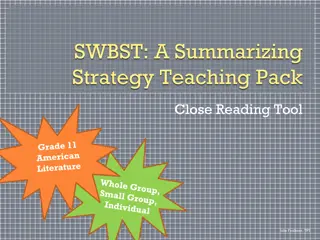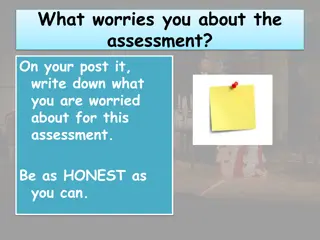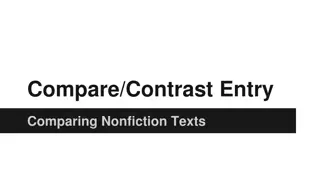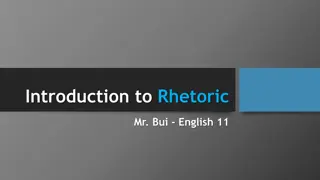Understanding SOAPSTone: An Analysis Strategy for Nonfiction Texts
Explore the SOAPSTone strategy which breaks down nonfiction texts into Speaker, Occasion, Audience, Purpose, Subject, and Tone. Understand how these elements help in analyzing and interpreting written pieces effectively.
Uploaded on Oct 05, 2024 | 0 Views
Download Presentation

Please find below an Image/Link to download the presentation.
The content on the website is provided AS IS for your information and personal use only. It may not be sold, licensed, or shared on other websites without obtaining consent from the author. Download presentation by click this link. If you encounter any issues during the download, it is possible that the publisher has removed the file from their server.
E N D
Presentation Transcript
SOAPSTone SOAPSTone
SOAPSTone SOAPSTone A mnemonic device that provides an attack strategy for reading and analyzing nonfiction
SOAPSTONE S=Speaker O=Occasion A=Audience P=Purpose S=Subject T=Tone
Speaker S=Speaker: who is giving the information? Can be an individual speaking for him/herself or a person speaking on behalf of a group what kind of person is he/she? what does he/she value?
Speaker S=Speaker: Colin Kaepernick FOR Nike Kaepernick first knelt during the national anthem as a player for the San Francisco 49ers in 2016 he was protesting injustices against minorities (like police brutality against unarmed Black men) So, if he speaks for Nike, we then understand that Nike supports issues of social justice equality
Occasion O=Occasion: addresses how time, place, culture, background prompt the writing of the piece Larger Occasion an environment of ideas, attitudes, and emotions that swirl around a broad issue the bigger picture Immediate Occasion an event or situation that catches the writer s attention and triggers a response it s the here and now that prompts the piece essentially, it s the context
Occasion O=Occasion: addresses how time, place, culture, background prompt the writing of the piece Larger Occasion police brutality, Black Lives Matter movement, attacks by President Trump against athletes who protest by kneeling during the anthem Immediate Occasion start of 2018 NFL season, 30th anniversary of Just Do It essentially, it s the context
Audience A=Audience: To whom is the piece directed? Who may see it/read it anyway?
Audience A=Audience: Writer/speaker takes into account the audience s experiences, expectations, feelings, and knowledge about the subject: NFL fans Kaepernick fans People who disagree with kneeling President Trump The NFL itself (is it a rule to stand or not?) Nike fans *I read up on this; Nike says it is targeting 15-17 year olds. Note that research indicates younger people are more tolerant/inclusive.
Purpose P=Purpose: goal that the author wants to achieve why d he/she write it?
Purpose P=Purpose: goal that the author wants to achieve why d he/she write it? To bring awareness about issues that hinder people of color To legitimize protest To encourage activism To sell shoes
Subject S=Subject: the focus or main topic of a piece
Subject S=Subject: the focus or main topic of a piece Protest, activism, personal integrity, sacrifice
Tone Tone: an author s opinion about/feelings toward the subject matter *An author s attitude refers to a judgment the author makes about the subject matter and is intellectual
Tone Tone: an author s opinion about/feelings toward the subject matter *An author s attitude refers to a judgment the author makes about the subject matter and is intellectual: Defiant Encouraging Proud























